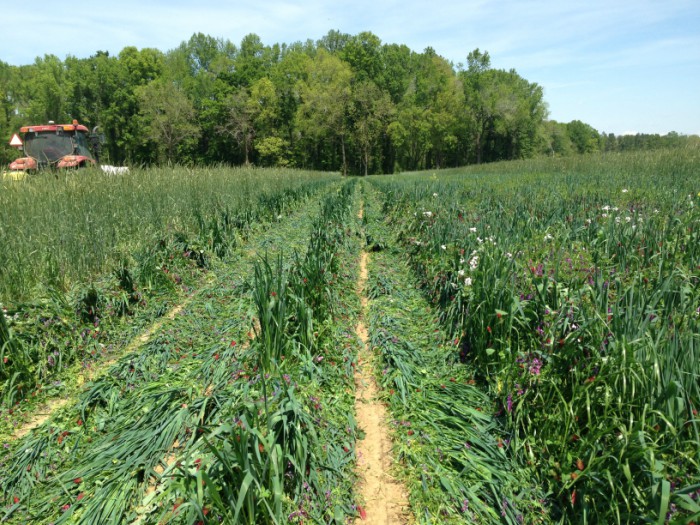Cover Crop Mixtures

Quick Look:
- Soil health. Cover crop mixtures may increase microbial community diversity, but research in agricultural production systems in the Southern region is limited. A diverse microbial community can increase soil carbon, solubilize micronutrients, resist pathogens and increase resilience.
- Functions. Cover crop mixtures can provide several functions, for example, both nitrogen fixation and residue for weed suppression. There are tradeoffs, and mixtures may not maximize any particular function.
- Yields. Research in Tennessee on silt loam soils found increased soybean yields with a multi-species cover crop mixture compared to single species cover crops or grain/legume mixtures after three years. This data indicates it may take three years or more to see a response to cover crop mixtures. Sandy soils may take even longer to show a response.
- Species selection. Choose at least one species from the six functional groups depending on your goal for the cover crop. Think about choosing complementary growth forms. Try to use varieties with similar maturity dates. Before corn, you should choose early-maturing varieties of cover crops. Before cotton or other later planted cash crops, later maturing varieties should be used.
- Brassicas. Radishes and other brassicas do not winterkill in the southern Coastal Plain and may not be a good fit before late-planted cash crops such as cotton.
- Grain/legume mixtures. Research in North Carolina and other southern states indicate grain/legume mixtures work well in many agricultural production systems. The grain provides longer lasting residue in a no-till system and helps slow down nitrogen release from the legume. The legume can also help offset nitrogen immobilization that can occur with high biomass grain cover crops.
- Termination. Glyphosate alone will not terminate most mixtures. Consider herbicide residuals and consult local Extension. For organic production, a mixture with varieties that have similar maturity dates will help provide a good kill with roller/crimpers. Best termination with roller/crimpers is obtained at 2/3 bloom with legumes and soft dough stage with grains.
- Costs. Although mixtures can be more expensive than single species, with careful thought you can create a mixture that is comparable in cost to a cereal rye monoculture.
There is a lot of interest in cover crop mixtures. Some farmers report improvements in soil as well as yields with their use. Interest in cover crop mixtures has been driven by a desire to mimic the natural prairie ecosystem. In many ecosystems, there is high biodiversity in vegetation that contributes to the stability of the ecosystem. Agro-ecosystems have much less biodiversity. Planting a mixture of covers crops increases the biodiversity of farming systems, which may increase soil health and increase the number of benefits a cover crop can provide.
Different cover crop species in a cover crop mixture have different root structures that access different areas in the soil as well as release a variety of substances (root exudates) that microbes use as food. The assumption is that the presence of many different types of plants with different root exudates and structures will create a more diverse microbial community, which will increase soil carbon, solubilize nutrients, resist pathogens and be resilient to disturbance. There is research to support this assumption, but most of it has not been conducted in Coastal Plain soils of the Southern United States. The very sandy soils found in the Coastal Plain and the very hot, humid conditions may change how our soils will respond.
Cover crop mixtures can provide a variety of benefits. For example, in a no-till or strip –till system, grains in the mixture provide a longer lasting residue that helps with reducing erosion, reducing soil temperature, preventing crusting, adding carbon, and weed suppression. Cover crop residues rolled and crimped to form a mat at the soil surface also moderate soil temperatures, which reduces crop stress. Legumes fix nitrogen that may be available to the following cash crop. Brassicas can scavenge nitrogen, may alleviate compaction, and provide early pollen as well as nectar for pollinator and beneficial insects. A cover crop mixture will provide some of all these benefits; however, research has shown that the mixture may not maximize any of these functions. For example, a cover crop mixture would not provide as much long-lasting residue for weed suppression as a cereal rye cover crop. Whether or not a mixture is right for your operation will depend on the benefits you want the cover crop to provide.
Many farmers wonder whether cover crop mixtures will increase yields. The University of Tennessee conducted one of the few studies of complex cover crop mixtures in the South. This research evaluated the effect of cover crop mixtures on yield in a corn-soybean rotation using a no cover crop control, a wheat monoculture, a cereal rye monoculture, a cereal rye/hairy vetch mixture, a cereal rye/crimson clover mixture, and a 5-species mixture containing cereal rye, oats, daikon radish, purple top turnip, and crimson clover. After three years, soybean yields were greater in the 5-species cover crop mixture treatment than the other treatments. There was no difference seen in soil organic matter between the cover crop treatments during this relatively short time frame. All the cover crop treatments, except cereal rye, had greater soil inorganic nitrogen than the no cover control, and most had greater potentially mineralizable nitrogen than the control. Although this study was conducted in a hot, humid climate similar to the Coastal Plain, the soils where the study was conducted were silt loams. These finer textured soils are likely to respond more quickly to cover cropping than the sandy soils of the Coastal Plain, because the greater amount of clay in the soil tends to protect soil organic matter from decomposition.
There are several things to consider when designing a mixture. The first is functional groups. Cover crop species can be grouped by when they grow and plant family. These groups roughly correspond to the function of the cover crops. The six functional groups are fall/winter planted small grains, legumes and brassicas, and spring/summer planted grains, legumes, and broadleaf plants. Information on specific species are found in the Cover Crop Information Sheets. Depending on your goal for the cover crop mixture, you would first select the season when you are planting and then species from the plant families. Some farmers select more than one species to provide redundancy. For example, if you wanted persistent surface residue for weed control and some nitrogen provided by the cover crop, you might select cereal rye, oats, and crimson clover. This example has two species from the fall/winter planted grasses for redundancy and a legume.
Another consideration is the growth form of the cover crop. By selecting species with complimentary growth forms, you reduce competition between species. For example, tall and open-canopied species, such as pearl millet, are complimentary to vining species, such as cowpeas. Oats have been shown to better compete with vetch than wheat or barley.
Try to select varieties that mature at a similar time. This will help prevent having one species setting viable seeds before you are ready to terminate the cover crop. For example, before corn, you may want to use an early maturing grains such as FL401 (cereal rye), oats (Legend) with brassicas and an early maturing crimson clover (AU Robin or AU Sunrise). For later planted cash crops such as cotton, later maturing varieties should be used. Forage variety trials are good source of information for varieties that perform well in your state. Usually forage variety trials report heading date for grains.
You should think carefully about when to include brassicas in your mixture. Brassicas do not generally winterkill in the Coastal Plain, particularly south of North Carolina. These grow quickly in the winter and flower in late February to early April. This means brassicas may produce viable seed by the time the cover crop is terminated for a late-planted crop such as cotton. Brassicas could be a good fit before early-planted cash crops such as corn, since the cover crop mixture would be terminated much earlier.
One type of cover crop mixture that has been used extensively is grain/legume mixtures. Grain/legume mixtures such as cereal rye and crimson clover can provide close to the same amount of biomass as a grain monoculture. This mixture can slow down the nitrogen release from the legume to better synchronize nitrogen with cash crop.
the legume can also help reduce potential nitrogen immobilization caused by large amounts of carbon in the small grains. In no-till or strip-till systems, the grain also provides a longer lasting residue than a monoculture legume that helps suppress weeds and well as protect the soil. Most farmers using a grain/legume mixture plant ½ to ¾ of the full legume seeding rate and ¼ to ½ of the full grain seeding rate.
The proportion of grain versus legume biomass obtained by planting a mixture depends on the soil, planting date, and climate conditions as well as the seeding rate. If a grain/legume mixture is planted in soils with a high inorganic nitrogen content, the grain will dominate the mixture. If the grain/legume mixture is planted in low inorganic nitrogen soils, the legume will typically dominate the mixture, because legumes can fix their own nitrogen. Legumes will also tend to produce more biomass when planted at the optimum time – typically September to October in the Coastal Plain. Legumes usually need enough time in the fall to produce good roots before they can create aboveground biomass. Grains, particularly cereal rye, can grow when planted later in the fall. Extremely wet or cold conditions in the fall and winter can also change the proportion of grains to legumes. Very high seeding rates can suppress legume biomass. Planting a small-seeded legume at the same depth as the grain, which can happen when both are mixed in the large seed box, can also reduce legume biomass.
Termination of complex mixtures can present challenges. When designing a cover crop mixture for your farm, think about the herbicide residuals and how what you use to terminate can affect cash crop. Termination of cover crop mixtures with herbicides usually requires a combination of glyphosate and other herbicides for a complete kill. More information on terminating cover crop with herbicides can be found here. You should consult your local Extension for specific recommendations in your area. Mixtures can be terminated with roller/crimpers without herbicides but timing may be difficult. Rolling and crimping requires the plant be in the reproductive stage to kill it. Choosing varieties that may mature at similar times is critical to get a good kill with roller/crimpers. In general, best termination is obtained when the legumes in the mixture are at 2/3 bloom and the grains are at soft dough stage.
Mixtures can be expensive to plant (Table 1). However, with careful planning, you can create a mixture comparable in cost to a cereal rye monoculture. An economically 6-species mixture that grows well before corn in Georgia is cereal rye (18 lbs/ac), oats (12 lbs/ac), vetch (3.5 lbs/ac), crimson clover (5.5 lbs/ac), daikon radish (1.75 lbs/ac), and rapeseed (1 lbs/ac).
Additional Resources:
- https://southerncovercrops.org/wp-content/uploads/2018/11/Multispecies-singlespecies-CC.pdf
- https://southerncovercrops.org/wp-content/uploads/2019/03/Cover-Crop-Mixture-Selection-and-Management.pdf
- https://www.sare.org/Learning-Center/Books/Building-Soils-for-Better-Crops-3rd-Edition/Text-Version/Cover-Crops/Types-of-Cover-Crops
- https://organiccommodities.ces.ncsu.edu/2018/02/biomass-production-with-legume-and-small-grain-cover-crop-mixtures-in-north-carolina-research-summary/
- Clark, A.J., Decker, A.M. and Meisinger, J.J., 1994. Seeding rate and kill date effects on hairy vetch-cereal rye cover crop mixtures for corn production. Agronomy Journal, 86(6), pp.1065-1070.
- Daniel, J.B., Abaye, A.O., Alley, M.M., Adcock, C.W. and Maitland, J.C., 1999. Winter annual cover crops in a Virginia no-till cotton production system: I. Biomass production, ground cover, and nitrogen assimilation. J. Cotton Sci, 3, pp.74-83.
Contributors:
Julia Gaskin, Extension Specialist, University of Georgia; Nicholas McGhee, Agronomist, Jimmy Carter Plant Materials Center; Nathan Lowder, Soil Health Specialists, NRCS; Peyton Sapp, Burke County Extension, University of Georgia
